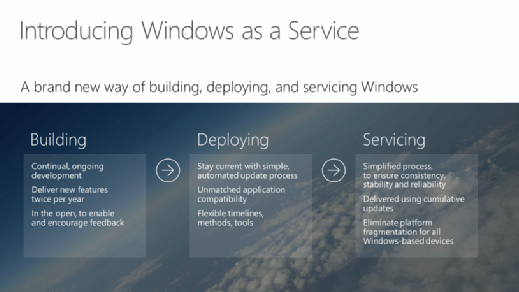Windows as a service
What is Windows as a service?
Windows as a service is the approach Microsoft introduced with Windows 10 to deploy, update and service the operating system.
Instead of releasing a new version of Windows every three to five years, as the company did with past iterations of the OS, Microsoft will continually update Windows 10 and Windows 11. The updates are categorized in two ways: feature updates and quality updates.
Feature updates occur about twice a year, roughly scheduled for March and September. They contain new functionalities for the OS. Quality updates are cumulative updates that come out at least once a month and contain security patches and other fixes to make the OS more reliable. Because they are cumulative, the latest update carries all updates that came before it and trumps any previous updates. Each feature update continues to receive quality updates for 18 months after its initial release.

Servicing options for Windows client updates
IT professionals can use the three servicing channels within Windows as a service to create deployment groups with different users or devices that they deliver the updates to at different cadences. The three servicing channels are as follows:
Windows Insider Program. Members of the Windows Insider Program get access to whatever updates are coming as soon as they are available during Microsoft's development process. This allows IT to work with the updates and test compatibility before the update goes out to an organization's users and the general public. In addition, Microsoft encourages members of the Windows Insider Program to provide feedback on any issues they encounter. The gestation period for updates is about four months, but it depends on the feedback Microsoft receives from Insider members. When an update is ready for general use -- meaning customers, independent software vendors and Microsoft partners consider it functional -- Microsoft declares it to be "ready for broad deployment."
General Availability Channel. With this approach to Windows servicing, feature updates are accessible and deployable on an annual basis rather than immediately after their release. Organizations can still test the updates before pushing them out to an entire organization's Windows environment, but this channel offers less advanced testing opportunity than the Windows Insider Program.
Long-Term Servicing Channel (LTSC). This channel is designed for specialized devices such as ATMs and other kiosk endpoints where security and stability are paramount and the downtime associated with OS updates is unacceptable. The LTSC, available only for the Windows 10 Enterprise Long-Term Servicing Branch edition of the OS, blocks feature updates but allows quality updates to continue. IT can defer the quality updates using Windows Update, Windows Update for Business, WSUS or SCCM. Updates in the LTSC occur about once every three years, and IT can implement them through in-place upgrades.
Servicing tools for Windows
IT can use many of the same management tools it used in previous versions of Windows to control updates, including the following:
Windows Update. With Windows Update, IT can pick and choose which devices are part of the Semi-Annual Channel and which devices within that channel can defer updates.
Windows Update for Business. In addition to deciding which devices defer updates, Windows Update for Business allows IT to centrally manage updates through Group Policy. IT can defer updates with Windows Update for Business for up to one full year. Windows Update for Business is also available in the cloud with Microsoft Intune.
WSUS. The deferment options go a step further with WSUS, as IT professionals can approve when the update goes to different specific devices or groups of devices.
SCCM. With SCCM, IT can defer and approve updates, as well as target specific devices or groups of devices and manage how much bandwidth the Windows update consumes and when the update runs.
Windows as a service in the past
Prior to Windows 10, Windows as a service referred to a delivery method for Windows virtual desktops and applications through a cloud service provider.
With that model, the service provider managed the back-end responsibilities of data storage, backup, security, patches, and upgrades. It copied the customer's personal data to and from the virtual desktop during logon and logoff. Similar to desktop as a service, IT purchased Windows as a service on a subscription basis. According to Microsoft's virtualization licensing policy, the end user was required to hold valid license keys for each Microsoft product IT pushed to their virtual desktop.



